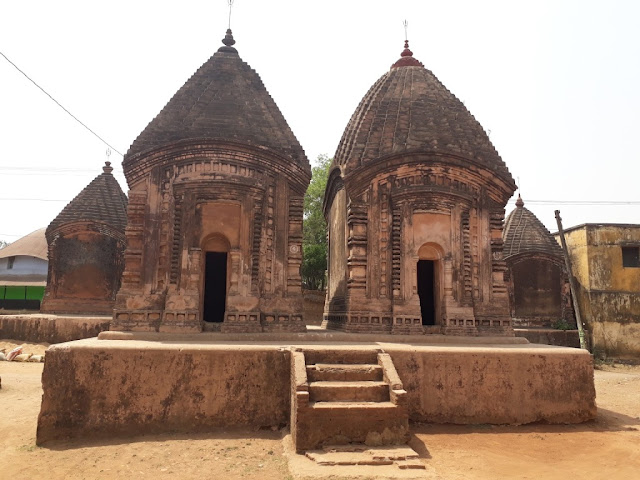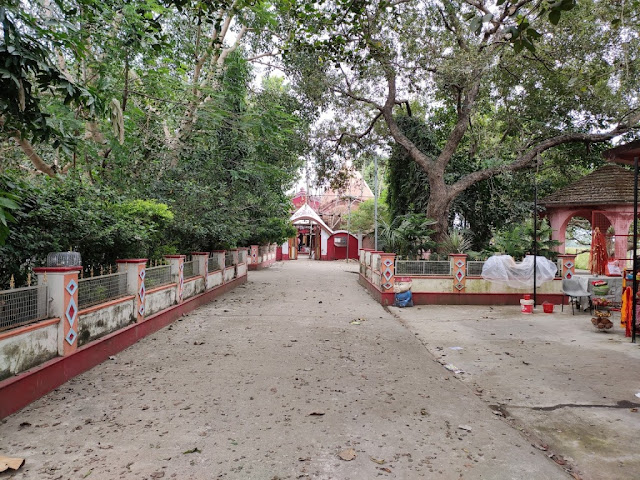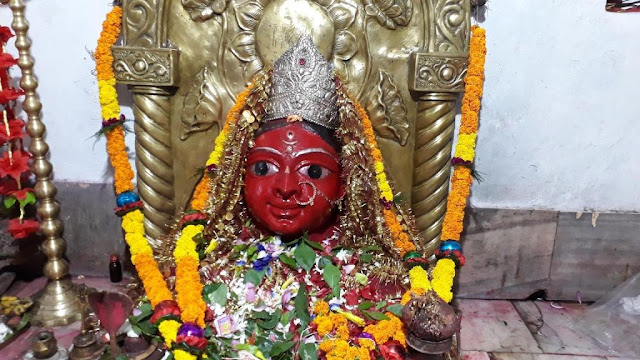Maluti Temples – Group of Temples
Maluti village houses 72 ancient temples presently. It is said that the Maluti village once housed 108 temples but lost around 36 temples due to nature’s fury and negligence in maintenance. All these temples are located within a radius of 350 metres (1,150 ft). Most of these 72 temples are in semi-dilapidated condition. These temples are dedicated to different denominations of gods and goddesses of Hindu pantheon, mainly to the tutelary deity Mauliksha, and others such as Shiva, Durga, Kali and Vishnu.
The temples are grouped into five different clusters namely Sikir Taraf, Rajar Bari, Madhya Bari, Chhoi Taraf and the Mauliksha temple complex. The largest of the clusters is the combined group of Rajbari and Sikir Bari, filled with several temples different in size and shape. Sikir Bari houses the roofless hexagonal Rasmancha. The Chhoi Taraf cluster is filled with temples made in charchala style. The architectural style of the temples may be classified into five categories namely Chala, Rekha, Mancha, Ek-Bangla and Flat roofed. All these styles are predominantly Bengali except the rekha style which originated in Odisha.
Out of the 72 temples in the village, 57 are Chala temples, 12 are flat roofed temples and Rasamancha, Rekha & Ek-Bangla temples are one each. Out of these temples, 30 Chala temples and one Rekha temple are decorated with terracotta plaques on their facades. Out of this 31 temples, terracotta facades of 7 are intact even at present. 18 temples are partly decorated and 5 have suffered badly from stealing of plaques by antique thieves, poor maintenance and nature’s fury. One terracotta temple is completely dilapidated.
Mauliksha Temple:
The main temple of Maluti Village is Mauliksha Temple. This temple is facing towards west. This temple follows Ek-Bangla style architecture. The Ek-Bangla (do-chala) consists of a hut with two sloping roofs, following the pattern of huts, mostly in East Bengal villages. It consists of sanctum and small verandah. The idol of Goddess Mauliksha has been placed on a square altar inside the sanctum.
Mother Mauliksha is considered as the tutelary deity of the Kings of Maluti Kingdom and guardian deity of Maluti village. Interestingly, this goddess is not found in any Hindu scriptures but is found in Vajrayana Buddhism as the Goddess Pandora. Maluti might be under the influence of Buddhism in ancient past and during the Hindu resurgence, this goddess might have been absorbed into Hindu pantheon. She is said to be the elder sister of goddess Tara.
Rasmancha:
There is only one temple in Maluti village which follows Mancha style. Tulsimancha, Dolmancha, and Rasmancha are the architectural styles comes under Mancha style. Rasmancha is the larger among them. This temple is octagonal in shape and stands over a raised plinth with archway openings on all sides. The prime purpose of this type of temple is to enable the deity to be seen from all sides. This temple is dedicated to Goddess Kali.
Chala Temples:
Chala temples are constructed in the form of traditional thatched huts seen in the villages of Bengal. This type of temple is simple in construction. It consists only one chamber built on square platform. Chala temples are dedicated to Lord Shiva. Three Chala temples have unique shikara combining mosque, church and temple. 30 Chala temples are decorated with terracotta plaques on their facades. Other three sides are left plain.
Flat-roofed Temples:
Flat-roofed Temples are very simple in construction and rectangular in plan. Three sides are covered with walls and front sides are open. The opening on front side is wider with pillars supporting the roof. Most of the temples are dedicated to Vishnu, Durga and Kali. There is a row of human bust in a straight line on the front side just below the cornice of one dilapidated Durga temple in this group. This design indicates the influence of English architecture imported by East India Company during the 18th century CE.
Rekha Deula:
There is only one temple in Maluti village which follows Rekha deula style. This style is quite common in the state of Odisha, adjacent to the state of Jharkhand. This temple is dedicated to Lord Shiva.
Bamakhyapa Temple:
There is a temple dedicated to a saint known as Bamakhyapa where his trident has been deified.
Terracotta Plaques:
‘The temples have been decorated with terracotta plaque depicting the scenes from the epic Mahabharata & Ramayana, Dashavatara, Dasa Maha Vidyas, Sapta Matrikas, Navagrahas, Krishna Leela, various depictions of Lord Shiva, Durga, Ganesha, Kartikeya, Lakshmi, Saraswathi, the fight between Durga and Mahishasura, scenes of village life and animals. There is a unique terracotta plaque of Lord Krishna with six hands. His hands holds bow, arrow, flutes, singa and sword.
Inscriptions:
There are a few inscriptions on the
temples recording the donor’s name, the date of construction and the
socio-political history of the period. Most of these inscriptions are dated in
Shaka era and in old Bengali script. The inscriptions are written in Sanskrit,
Prakrit and Bengali. Some of the inscriptions in this temple records the date
of construction in literature form (like a cipher). The donor’s name and the date
of construction can be gleaned after deciphering the inscriptions.

























No comments:
Post a Comment